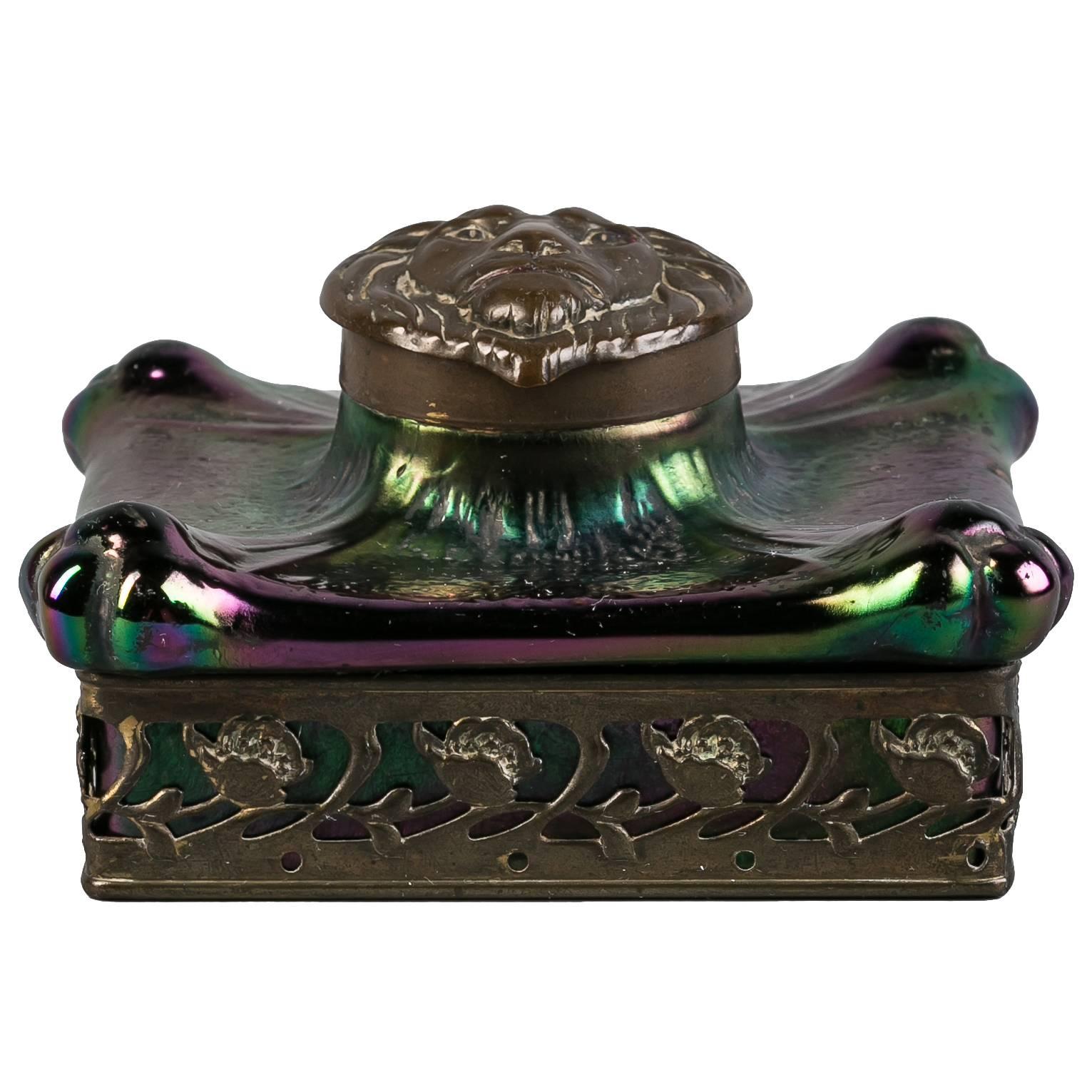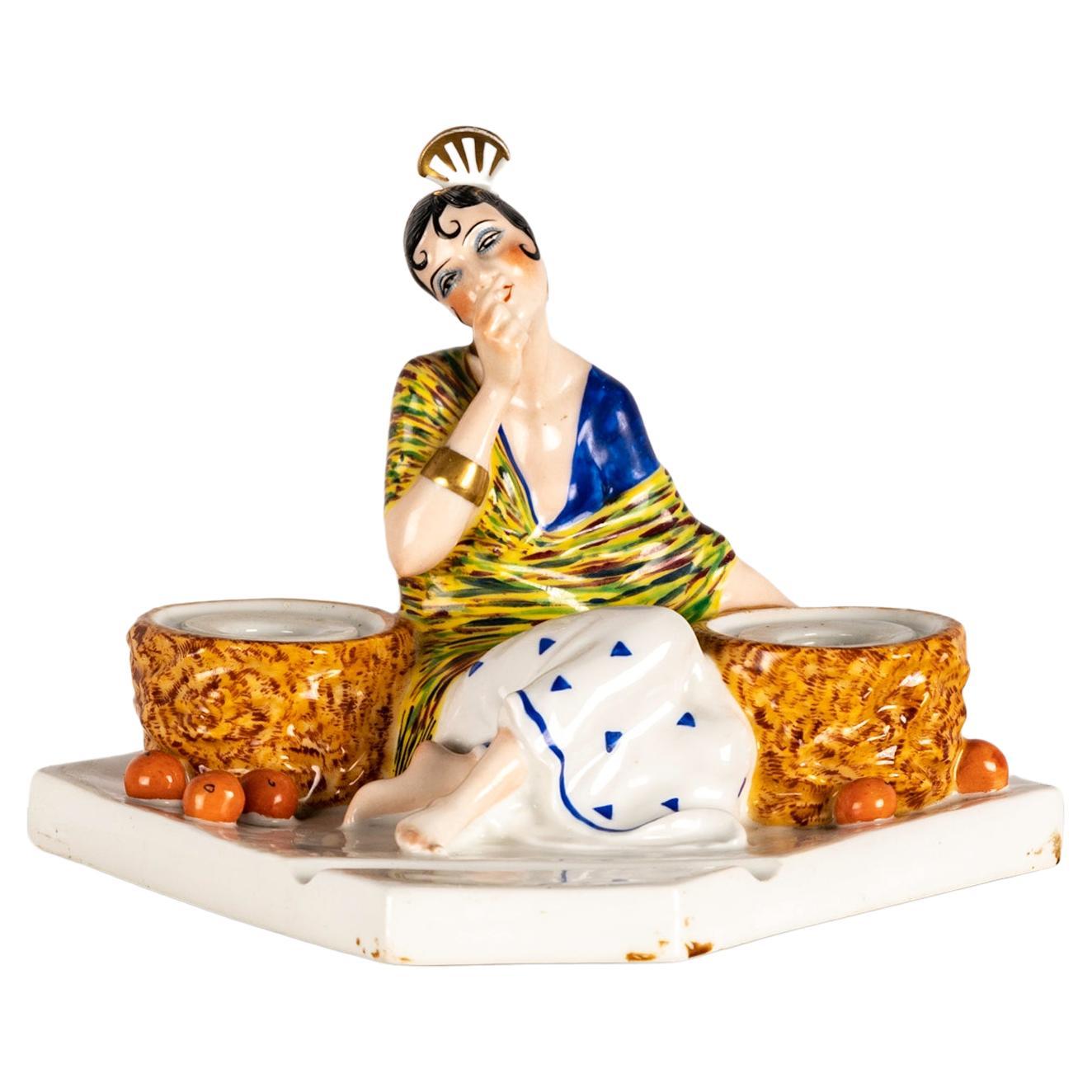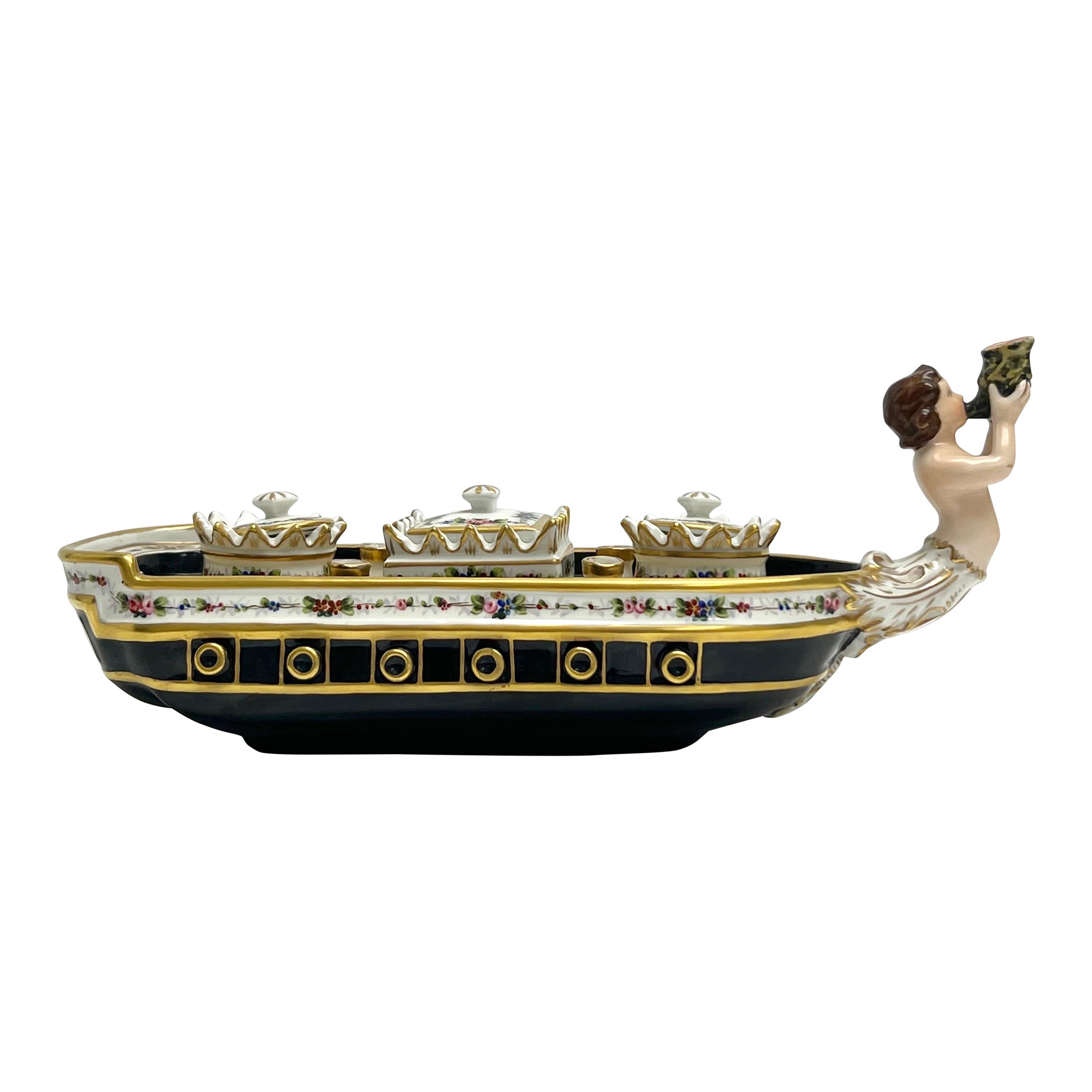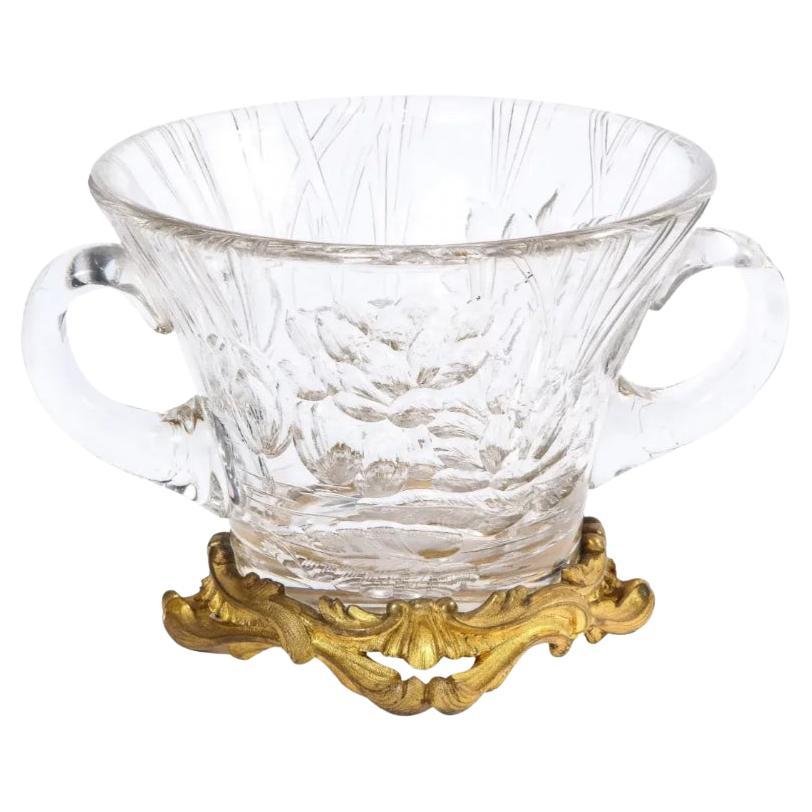Famille Rose Qianlong Period Enamel Inkwell by L'Escalier de Cristal C.1880
About the Item
- Creator:L'Escalier de Cristal (Maker)
- Dimensions:Height: 4.34 in (11 cm)Width: 14.97 in (38 cm)Depth: 7.88 in (20 cm)
- Style:Japonisme (Of the Period)
- Materials and Techniques:
- Place of Origin:
- Period:
- Date of Manufacture:circa 1880
- Condition:Wear consistent with age and use.
- Seller Location:Saint-Ouen, FR
- Reference Number:1stDibs: LU2612333939202
L'Escalier de Cristal
Dating back to the Bourbon Restoration in France and the reign of Napoleon Bonaparte, l’Escalier de Cristal (the Crystal Staircase) was founded by Madame Veuve Désarnaud as the first company to offer decorative objects made from crystal and gilded bronze. The firm was located in the Palais Royal in Paris, opposite the Louvre. It grew through a series of owners to become the gold standard for reproductions of 18th-century furniture — so perfect they were often mistaken for originals.
Désarnaud won numerous awards for her creations, including a gold medal at the 1819 Paris Exposition des Produits de l’Industrie Française for a dressing table featuring her signature bronze-crystal combination. A tailor named Boin bought the company around 1830; he in turn sold it to Pierre-Isidore Lahoche in 1840. Lahoche’s son-in-law, Émile Pannier, joined in a partnership in 1952 before Émile’s sons took over in 1885, establishing Pannier Frères. The company ceased commercial production in 1923.
Starting as early as the 1860s, there was a growing appetite for Japanese-style furniture, thanks in large part to the Japanese pavilion at the International Exposition of 1867. Henry Pannier reimagined some of the company’s designs to meet this new demand. The stylized furniture was a huge success and earned the company many awards, including the gold medal at the 1900 Paris Exposition Universelle. Others who contributed to this stylistic trend included French artist Émile Gallé, French glassmaker and ceramicist François-Eugène Rousseau, French furniture designer Louis Majorelle and French cabinetmaker Gabriel Viardot.
Henry Pannier made a constant effort to sketch each object the company sold and record it in his notebooks. Over 50 years, he recorded 2,800 furniture designs, each with its own name, date of sale and price. On some pieces, l’Escalier de Cristal signed the models, adding a layer of authenticity and distinction for today’s collectors.
Museums around the world have collected pieces from l’Escalier de Cristal, including the State Hermitage Museum in Saint Petersburg, the Musée d'Orsay in Paris and the Corning Museum of Glass in New York.
On 1stDibs, find a collection of l’Escalier de Cristal decorative objects, vases, desk accessories and more.
- ShippingRetrieving quote...Ships From: Saint-Ouen, France
- Return PolicyA return for this item may be initiated within 2 days of delivery.
- French 19th Century Aesthetic Movement Chinoiserie Timepiece by Susse FrèresBy L'Escalier de Cristal, Susse FreresLocated in Saint-Ouen, FRA very fine bronze brown and gilt patina French 19th century timepiece in the oriental Chinese taste. In an Archaic style bell with molded relief dragons circling body, surmounted by...Category
Antique 1860s French Chinoiserie More Clocks
MaterialsBronze
- "Ce qu'évoquent les Livres" by Émile Aubry '1880-1964'By Louis AubryLocated in Saint-Ouen, FR"Ce qu'évoquent les Livres" Allegory of the Literature Oil on canvas Signed on the lower part beside parchment 111 x 133 x 2 cm Framed 125 x 146 x 7 cm Provenance: Collection Georges AUBRY, brother of the artist Bibliography: Illustrated in catalogue «Regards de peintre» , Suzanne AUBRY-CASANOVA, 1997, p.104 After trying years of forced confinement due to the war, he composed this allegorical fresco on the theme of Literature, Science and Arts was painted by Émile Aubry for his younger brother Georges Aubry, who had intended it for his library. This work, composed on the theme of the book it symbolizes, in its diversity by allegorical characters, he cannot help ordering the painting around Art, which he places at the top of the scale of human...Category
Vintage 1940s French Art Deco Paintings
MaterialsCanvas
- Émile Gallé (1846-1904) French Enameled Ring Tree Cristallerie circa 1885By Emile GalléLocated in Saint-Ouen, FRÉmile Gallé (1846-1904) Extremely Rare Baguier shaped tree trunk blue “light blue moon” (Clair de Lune) glass enameled designed with two grasshoppers, an ant and a fly. Signed E.Gall...Category
Antique 1880s French Japonisme Glass
MaterialsArt Glass
- Pair of Porcelain Vases Ormolu-Mounted in Lamps by Gagneau Paris XIXth CenturyBy Gagneau ParisLocated in Saint-Ouen, FRPair of large Japanese Porcelain Cone Shape Vases with Imari decoration Important mounts in ormolu and gilded metal, the base decorated with a laurel wreath, the upper part of falling leaves and a frieze of knotted ribbon. The mounts signed Gagneau, 115 R. Lafayette. Circa 1860 With their original aluminium bulb cover and original gilding Vase it self Height 47 cm The Gagneau Company is one of the most famous lighting factories in Paris in the nine-teenth century, established in 1800 at 25 rue d'Enghien in Paris and later at 115 rue de Lafayette. She has participated in many exhibitions throughout this century. She began in 1819 with the Exposition des Produits de l'Industrie and later participated in the Universal Exhibitions where she was part of the jury in the category of art bronzes (class 25) at the Universal Exhibition in Paris in 1889. "Imari" was simply the trans-shipment port for Arita wares, from where they went to the for-eign trading outposts at Nagasaki. It was the kilns at Arita which formed the heart of the Japanese porcelain industry. Arita's kilns were set up in the 17th century, after kaolin was discovered in 1616. A popular legend attributes the discovery to an immigrant Korean potter, Yi Sam-Pyeong (1579–1655), although most historians consider this doubtful. After the discovery, some kilns began to produce revised Korean-style blue and white porcelains, known as Early Imari, or "Shoki-Imari". In the mid-17th century, there were also many Chinese refugees in northern Kyushu due to the turmoil in China, and it is said that one of them brought the overglaze enamel coloring technique to Arita. Thus Shoki-Imari developed into Ko-Kutani, Imari, and later Kakiemon, which are sometimes taken as a wider group of Imari wares. Ko-Kutani was produced around 1650 for both export and domestic market.Kutani Ware is characterized by vivid green, blue, purple, yellow and red colors in bold designs of landscapes and nature. Blue and white porcelain pieces continued to be produced and they are called Ai-Kutani. Ko-Kutani Imari for the export market usually adopted Chinese design structure such as kraak style, whereas Ai-Kutani for the domestic market were highly unique in design and are ac-cordingly valued very much among collectors. Ko-Kutani style evolved into Kakiemon-style Imari, which was produced for about 50 years around 1700. Kakiemon was characterized by crisp lines, and bright blue, red and green designs of dramatically stylized floral and bird scenes. Imari achieved its technical and aes-thetic peak in the Kakiemon style, and it dominated the European market. Blue and white Kakiemon is called Ai-Kakiemon. The Kakiemon style transformed into Kinrande in the 18th century, using underglaze blue and overglaze red and gold enamels, and later additional colors. Imari began to be exported to Europe when the Chinese kilns at Jingdezhen were damaged in the political chaos and the new Qing dynasty government halted trade in 1656–1684. Ex-ports to Europe were made through the Dutch East India Company, and in Europe the des-ignation "Imari porcelain" connotes Arita wares of mostly Kinrande Imari. Export of Imari to Europe stopped in mid-18th century when China resumed export to Europe, since Imari was not able to compete against Chinese products due to high labor costs. By that time, however, both Imari and Kakiemon styles were already so popular among Eu-ropeans that the Chinese export porcelain copied both, a type known as Chinese Imari. At the same time, European kilns, such as Meissen and English potteries such as Johnson Bros. and (Royal) Crown Derby, also imitated the Imari and Kakiemon styles. Export of Imari surged again in late 19th century (Meiji era) when Japonism flourished in Europe.Thus, in the western world today, two kinds of true Japanese Imari can...Category
Antique 1880s French Japonisme Table Lamps
MaterialsBronze
- French 19th Century Twelve Lights Restauration Period ChandelierLocated in Saint-Ouen, FRA twelve lights green patinated metal, bronze and ormolu restauration period chandelier.Category
Antique 1820s French Restauration Chandeliers and Pendants
MaterialsBronze
- A French 19th Century Louis XVI Style Side Table, circa 1880Located in Saint-Ouen, FRA very good quality 19th century French charming two-tier side table with a single frieze drawer parquetry inlaid, designed with Allegories of Geography and Astronomy, with pierced three-quarter gallery surround, above a foliate and loop frieze, the front with a drawer, ormolu mounts and raised on delicate cabriole legs. The Louis XVI furnishings and decorative style started in 1774, at the begin-ning of Louis XVI reign up until 1790. The Directoire style will succeed. It followed a European movement return to classicism in the second half of the eighteenth century. Louis XVI, grand-son of Louis XV, became king in 1774 at the age of 20. Queen Marie Antoinette also very much appreciated the decorative arts. The middle of the eighteenth century and the Louis XVI style furnishing has been heavily influenced by the discovery of the remains of Herculaneum (1738) and Pompeii in 1748. Thus, was born the neo...Category
Antique 1880s French Louis XVI Side Tables
MaterialsOrmolu
- Charming Japanese Style Tray Attributed to l'Escalier de Cristal, France, c.1880By L'Escalier de CristalLocated in PARIS, FRRare Japanese style diamond-shaped tray attributed to l'Escalier de Cristal, representing lake landscapes in cartouches, and adorned in its center with a lunch scene with a Japanese couple in traditional dress, all highlighted by a gilded decor of flowering branches on a pink porcelain background. The whole is framed by a gilded openwork bronze mount ending on the sides by two handles. “L’Escalier de Cristal”, an old and famous Parisian firm, specialized in glass products and ceramics but also suggested furniture and bronze sculptures. It was led from 1885 to 1923 by Emile Pannier’s sons, who gave the name of Pannier Frères to the society, located at the corner of Scribe street and Auber street, next to the new built Paris Opera house. Their Japanese style creations were among many others much appreciated by the critics and the public. They were awarded many medals at various exhibitions, such as the Gold medal at the 1900 Paris Universal Exhibition. Lots of artists participated in that world success, such as Emile Gallé, who gave to Pannier Frères the exclusive rights of some of his models, or François-Eugène Rousseau, who designed many vases and gave the model of his successful Japanese style dining-set as well. This set was made by the Creil et Montereau Manufacture. In the Japanese style furniture...Category
Antique 1880s French Japonisme Decorative Dishes and Vide-Poche
MaterialsBronze
- Japanese Style Planter Attributed to l'Escalier de Cristal, France, circa 1880By Edouard Lievre, L'Escalier de CristalLocated in PARIS, FRLarge planter decorated on the belly with a rotating decoration of polychrome flowers and geometric patterns in cloisonné enamel on a red background. It is inserted in an important p...Category
Antique 1880s French Japonisme Planters, Cachepots and Jardinières
MaterialsEnamel, Bronze
- Rare Japanese Style Planter by L'Escalier de Cristal, France, Circa 1880By L'Escalier de CristalLocated in PARIS, FRThis circular planter in enamel ceramic, by L'Escalier de crystal, is embellished with a floral and vegetal polychrome décor upon a celestial blue ...Category
Antique 1880s French Planters, Cachepots and Jardinières
MaterialsBronze
- Pair of "Cloisonne" Enamel Vases, Attr. to l'Escalier de Cristal, France, C.1870By L'Escalier de CristalLocated in PARIS, FRPair of Japanese-style roll-shaped vases, made in “cloisonné” enamel and gilded bronze. The cylindrical body is decorated with polychrom floral branches, flowers and butterflies on a...Category
Antique 1870s French Japonisme Vases
MaterialsBronze, Enamel
- Japanese Style Bronze Planter by L'Escalier de Cristal, France, Circa 1890By L'Escalier de CristalLocated in PARIS, FRSigned H.P for Henri Pannier. Lovely hexagonal shaped planter in patinated bronze with gold highlights. Adorned on three sides with a dragon framed by a rhombus frieze on an openwor...Category
Antique 1890s French Japonisme Planters, Cachepots and Jardinières
MaterialsBronze
- Elegant Porcelain Pot-Pourri Att. to l'Escalier de Cristal, France, circa 1880By L'Escalier de CristalLocated in PARIS, FRLarge enamelled porcelain perfume burner decorated with vines on a background of rose petals. The set is embellished with an elegant mount in chisele...Category
Antique 1880s French Louis XV Urns
MaterialsBronze






